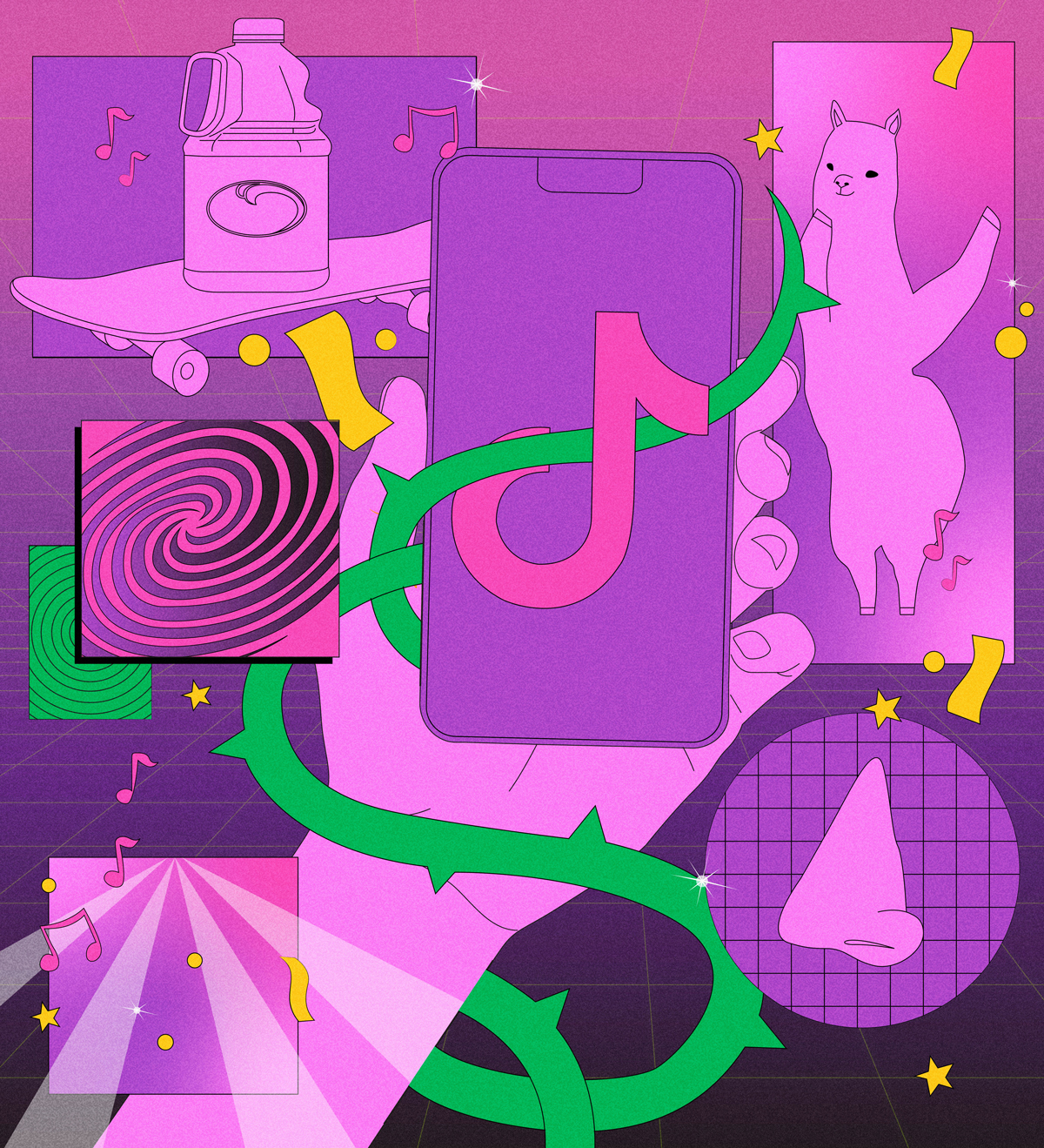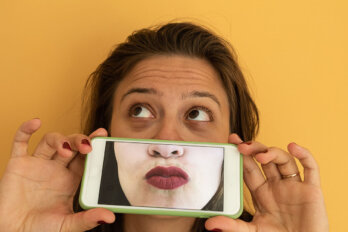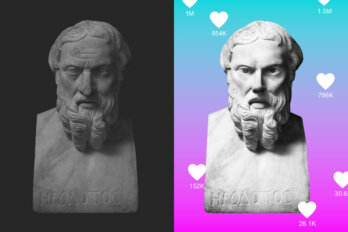Listen to an audio version of this story
For more audio from The Walrus, subscribe to AMI-audio podcasts on iTunes.
I downloaded TikTok in the first lonely months of self-isolation. The internet of millennials had grown stale, populated by overly posed pictures, inane hashtags, and SEO-friendly self-branding. TikTok promised something different: a space where a younger generation of users embraced idiosyncrasy and irreverence over conformity and overwrought styling.
Initially, I was skeptical. I knew TikTok mostly as the home of lip-syncing videos and dance challenges performed by floppy-haired teenagers in LA mansions. Also: Did I really need yet another social media app, especially one with seemingly dubious privacy commitments? But what I discovered was irresistible—an unruly playground populated by a generation whose modes of expression struck me as refreshingly honest and hilarious, a new way of imagining our online lives.
TikTok is a young platform, both in terms of the company’s age and that of its primary user base: according to market research company GlobalWebIndex, more than 40 percent of TikTokers were between sixteen and twenty-four in 2018. Less than two years after its merger with the Musical.ly app in the US, it has been downloaded more than 2 billion times and was the most downloaded entertainment app of 2020. The year’s most viral videos—a man skateboarding to Fleetwood Mac’s “Dreams” while drinking cranberry juice, an animated llama dancing to a Russian cereal jingle, a six-ingredient recipe for “carrot bacon”—sound alternately banal and bizarre. But, once you watch them, it’s easy to understand why the video-sharing platform, first launched in 2016 in China, has grown massively popular in the US and Canada.
The potent serotonin bursts of TikTok led Jia Tolentino to describe the app as “an enormous meme factory, compressing the world into pellets of virality.” But TikTok videos, or at least the best of them, tend not to feel engineered or optimized the way content on other platforms does—instead, they feel extemporaneous, genuine, and convincingly human. TikTok and its attendant digital amusements were “2020’s only silver lining,” writes Scaachi Koul for BuzzFeed, and during quarantine, the app became a reliable source of distraction just when we needed it most.
The more I scrolled through its videos, the more it became clear that TikTok’s much-reported generational differences from the millennial internet were not just a well-observed detail but rather the whole point. TikTok has become a core way for Gen Z to express its own ethos, aesthetic, and attitudes—sometimes resulting in outright hostility toward millennials and boomers (though rarely Gen Xers, forever the forgotten middle child). Millennials, especially, are frequently criticized on the app for their perceived immaturity and whining, their predilection for Harry Potter and BuzzFeed, and their overall corniness. In a post under #bullymillennials, a video montage mocks what it calls a “millennial core” aesthetic. A series of images flashes across the screen: a pile of avocado toast, a mock–election campaign shirt that reads “Doggo Pupper ’20: They’re heckin good boys,” the definition of the buzzword adulting, and the Harry Potter house crests. In another post, a Gen Z user rips into millennials with the claim that they have underperformed as a generation. “Y’all were supposed to be saving the climate, starting revolutions and shit. What did you contribute? Mumford and Sons? A craft brewery on every corner?”
At the same time as they used the app to poke fun at millennials, Gen Zers were also using it for their own self-identification. While the term millennial is typically used with derision, to signify a supposedly spoiled generation more interested in five-dollar lattes than in home ownership, and used only begrudgingly by millennials themselves, Gen Zers seem proud of their label. In September, the idea of getting a Gen Z tattoo even gained popularity on TikTok until some users pointed out that the tattoo design chosen—a Z with a line through the middle—accidentally resembled a Nazi symbol still used by the far right today.
It’s hard to say whether TikTok created this generational animosity or simply fanned the flames. But what is clear is that TikTok represents the apotheosis of a digital shift that divides millennials—who lived through the dawn of social media—and Gen Zers, who have never known life before complete self-digitization. The larger effects of this shift are still coming into view, but however much progress millennials may have made in digital self-creation, Gen Z has far surpassed them in making these online spaces more interesting—albeit, perhaps, at a cost.
In the 1980s, when online communication first entered widespread use, researchers Richard Daft and Robert Lengel pioneered a theory that looked at the variations in “richness” among different types of media. In this framework, in-person communication is generally considered the richest medium, while text-based forms of communication are comparatively “lean.” A medium like email is able to convey a large amount of information but without the subtle distinctions possible during in-person communication, like body language. In contrast to the platforms of the millennial internet, TikTok offers a “media rich” environment in which users receive a great deal of auditory and visual information—like seeing one another’s facial cues and hearing the intonation and pacing in one another’s voices.
Such closeness starts as soon as you open the app—you are immediately plunged into an unending stream of faces. Unlike users of Twitter or Instagram, TikTok users do not need to “follow” any accounts before they’re served content. Instead, a mysterious, uncannily accurate algorithm intuits the user’s preferences and presents them in a so-called “For You” page. Each video is sixty seconds or less and can touch on any possible subject. After a few months of use, my feed now shows me skits, dances, and observational quips posted by regular users in my own demographic, as well as content from astrologers, perfume connoisseurs, therapists, gastroenterologists, amateur bakers, and textile artists—all interests that TikTok has bafflingly but correctly assumed I have.
The specificity can be jarring. Unprompted, the algorithm has shown me content from other Bosnian women in their twenties who live in New York City, matching us down to the very same village. At other times, the predictive power of the algorithm turns almost omniscient. Over the summer, I had been ignoring a strange rash on my torso when I was offered a TikTok about someone else’s unidentifiable rash on their torso, which was eventually diagnosed as shingles. I went to my doctor, and sure enough, my diagnosis was the same. According to TikTok, the power of its algorithm is based on factors like viewer engagement on previous videos; the hashtags, songs, and captions contained in those past videos; and users’ location and language preferences. Through these data points, the app is able to connect you with users with similar interests and experiences, no matter how niche.
But what really makes TikTok unique—and what makes it especially appealing during a pandemic—is the feeling of intimacy and immediacy between users. Unlike platforms that trade only in words and still images, TikTok shares a steady parade of faces and voices during what has been perhaps the loneliest year of the past century. Though we can’t have the same physical proximity to one another in a pandemic, TikTok provides an uncanny feeling of closeness and camaraderie, like a FaceTime call shared with millions of strangers.
This intimacy may also be the reason for Gen Z’s generational allegiance. Where millennials were cloaked in mostly faceless anonymity online (on LiveJournal, Tumblr, Twitter) or highly curated photography (Facebook, Instagram), Gen Z’s digital life is dominated by the near-constant production of images and videos of themselves (Snapchat, TikTok), creating a very different relationship between them, their peers, and the rest of the world.
A user creating their first Myspace account had a limited number of vehicles for self-expression: a few grainy pictures taken on a wonky digital camera, a list of top friends, and maybe a few personalized layout and music choices. A few years later, posting a photo on Facebook or Instagram occurred only after thorough vetting. Compared to social media usage now, the way we interacted with these platforms was stilted, awkward, and deliberate. Because of the platforms themselves and because the idea of a digital identity was still fairly new, it was harder for millennials to really be themselves online. Posting quick, shareable videos, recorded and edited on one’s phone, became possible only relatively recently, and with it came a world of creative opportunities.
Until I downloaded TikTok, I had only known life as a member of the youngest existing generation to enter adulthood. Seeing a new generation of natural-born digital creators forced me to reconsider how I had lived my own life online. Gen Z has never known a time before the internet, whereas I have very distinct memories of the first social media account I ever made (a Myspace page in middle school) and the first time I ever watched a YouTube video (a concert recording of “Hey Jude” I found in the very early days of high school). I watched in real time as the internet’s now ubiquitous transparency and oversharing slowly developed through Tumblr, Twitter, blogging communities, and viral personal essays. The change was exhilarating, an antidote to growing up in a culture where so much of interest—sex, mental health—was and is still considered taboo.
Sharing, and sometimes oversharing, seems to be second nature to Gen Zers, which translates into their digital fluency and sense of openness online. But this frankness may come at a price. In revealing everything, we risk exposing too much of ourselves to an untrustworthy entity—in this case, a video-sharing platform valued at around $60 billion (US)—that is fuelled by our need for closeness.
TikTok’s stream of faces is arguably a form of transparency that has turned into exhibitionism. According to theorist Byung-Chul Han, the “compulsion for transparency flattens the human being itself, making it a functional element within a system,” which he describes as a kind of “violence.” To Han, “the compulsion to hand everything over to communication and visibility”—two characteristics that describe TikTok to a T—is something “obscene.” Though I value the frankness the app has brought out, and while it’s possible to have real and meaningful connections through digital platforms, I found myself wondering about the unseen costs, especially on young people.
There is a darker side to TikTok as well: impossibly fit and beautiful influencers; the same fixation on thinness and white, Eurocentric beauty ideals that exists on every other app; and trends that spawn harmful ideas about food and that promote and normalize plastic surgery. Combined with the algorithm, one’s own specific insecurities can feel magnified. I tried not to take it personally when “midsized girl” content and montages of rhinoplasty procedures began to appear on my feed. Perhaps, if I had been younger, the effect would have been different.
Gen Zers are coming of age during a period of intense loneliness. Though their digital lives offer them creative ways to bypass the effects of isolation, they have nonetheless—much like millennials—been deeply impacted by economic downturns, political instability, and a global pandemic. Eventually, as more people join TikTok and Gen Z grows older, they too will be pushed out by an even younger contingent.
The pandemic has revealed the upper limits of how far virtual connections will take us when the real thing isn’t possible. Gen Zers have managed to expand those limits somewhat and have made the internet more interesting as a result. They will still face the same challenges generations of adolescents have struggled with before—self-image, insecurity, social anxiety—but this time with the ability to magnify those insecurities through an omnipresent camera lens. The fact that young people are not only being exposed to these technologies but are currently unable to balance their online lives with in-person socializing can serve only to exacerbate the anxieties of adolescence—since, during COVID-19, to exist online can feel like the only way to exist at all.






